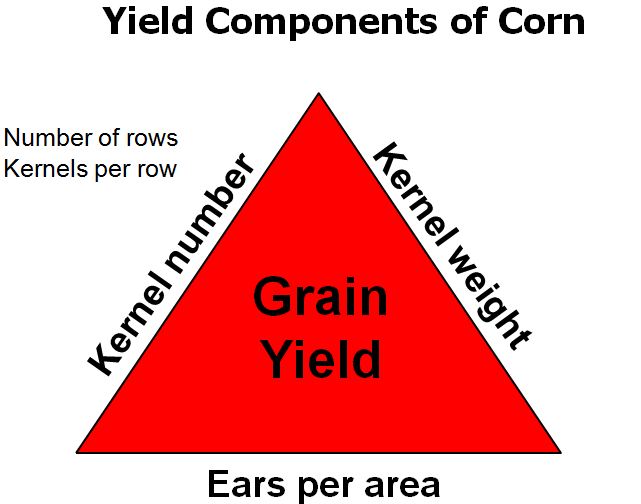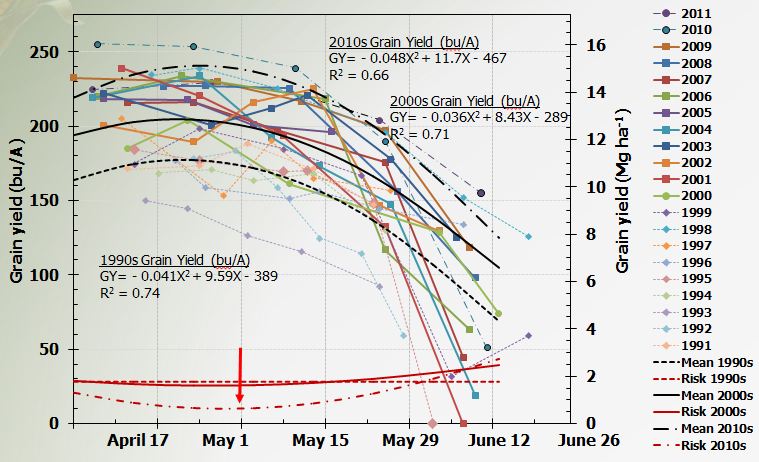Planting Season
Originally written February 1, 2006 | Last updated
May 09, 2016
The Planting Process: What Really Matters?
Uniform spacing requires perfect singulation and perfect seed placement. Misplaced, missing, and extra seed has relatively little impact on yield. Little yield improvement below plant spacing variability below 4 inches standard deviation.
Uniform emergence requires site-specific considerations involving water and temperature. (Get list of other factors).
The optimum planting window requires a favorable 5-day forecast, a soil that is "fit" to plant, and soil temperatures at least 50 F for the germination process to be initiated.
Key Success factors (% impact on yield)
Correct population = 1-2%
Uniform spacing = 1-2%
Uniform emergence = 5-9%
Planting window = 2-5%
Theory of Yield 

The Dimensions of Planting
The Dimensions of Planting
- Plant density
- Planting date
- Row spacing
- Seeding depth
Replanting / Late-planting
|
Plant Density
Handouts
Ideal plant population - depends on several factors:
- SOIL TYPE: Heavier, finer textured soils have better water holding capacity
and can support higher populations than lighter, coarser textured soils
- PLANTING DATE: As plant population increases, an early planting date becomes
more important
- HYBRID: Some hybrids tolerate high populations better than others. Maturity
is important. Shorter, earlier hybrids usually more responsive to high populations
than taller, later hybrids
- SOIL FERTILITY: High populations need high soil fertility
- MOISTURE: Need plenty of moisture for higher populations to be advantageous
- ROW SPACING: Optimum row spacing decreases as plant population increases
(in much of the Corn Belt).
- Optimizing plant density
- "Can't grow an ear in air!"
- Optimum range is between 28,000 and 32,000 plants per acre.
Row spacing
Handouts

- Wisconsin studies
- Michigan study
- Paired "Twin" Rows
Moisture influences response to row spacing. In Northern areas of the Corn Belt
response to row spacing has not been consistent. Response has not been very large
in Wisconsin. Consequently, most corn growers in Wisconsin plant corn in 30-inch
rows. Intensive managers in Wisconsin are growing corn in <30-inch rows.
- 30-inch v. 36- to 38-inch rows = 5-8% yield increase
- 30-inch v. less than 22-inch rows = 2% to 5% yield increase
|
Equipment Changeover Costs to Narrow Rows (Paskiewicz, 1996)
|
|
Replacing rims and tires
|
$8,000
|
|
Convert corn head
|
$6,500
|
|
Convert planter
|
$5,000
|
|
Convert sprayer
|
$500
|
|
Variable costs (fertilizer, fueld, etc.)
|
?
|
|
Tillage using residue clearing
|
?
|
|
Requires more time at planting
|
?
|
|
Cultivation difficult or impossible
|
?
|
Planting date
Handouts
Depends on soil type - A light soil dries out and warms up faster in the spring
than a heavy soil
Optimum date is usually May 1 to 7 in southern to northern Wisconsin
ADVANTAGES of EARLY PLANTING
- HIGHER YIELDS: Maturity is important - late hybrids usually respond better
to early planting than early hybrids
- Better response to fertilizer
- Better DRYDOWN in the fall
- Other benefits of early planting
- Stronger roots and stalks
- Lower ear height
- Plant height may be shorter
- In much of the Corn Belt, tasseling and silking may occur before hot, dry weather
arrives
- Earlier planting earlier shading of soil surface less water loss by evaporation
Early planting does not cost more than late planting
- Delayed planting during early May corn yields decrease 0.3 to 0.5% per day delay
- Delayed planting during late May, corn yields decrease 1.5 to 2.3% per day delay.
- Planting corn after May 20 returns $45 to $85 less per acre and costs $0.20 to $0.50
more per bushel to dry than planting May 1 to May 5.
Figure 1. Grain yield response of full-season corn planted on
various dates at Arlington, WI. The optimum date to plant corn is May 1.
Risk is defined as the standard deviation (i.e. spread) of the points
along the mean.

Seeding Depth
- Normally 1.5 to 2 inches
- Warmer soil temperatures are near the surface
- Mesocotyl pushes the growing point to within 1-inch of the soil surface
"Floppy" corn syndrome (a.k.a. "rootless" corn
or "high crown" syndrome)
- Symptoms: Young corn plants (V3 to V8) are often leaning or appear
ready to lodge. Before rootless corn is evident, corn plants may appear
vigorous and healthy, but after strong winds, plants will fall over
because there is no support. Leaning and lodged plants may also be
wilted. These plants lack all or most nodal roots and appear stubby and
blunt.
- Under favorable growing conditions, 4 to 5 sets of nodal roots
develop above the seed and comprise the permanent root system of corn.
The nodal roots are important in providing water and mineral nutrients
that the corn plant needs for normal growth.
- Rootless corn problems are usually caused by weather related
conditions that coincide with development of the nodal root system such
as hot, dry surface soils, shallow planting depth, compact soils, loose, or
cloddy soil conditions. Nodal roots will not grow into hot, dry compact
soils. Also, the abrasive action of strong winds can break off secondary
roots and inhibit establishment of the nodal root system. Excessive
rainfall and shallow plantings may cause erosion and soil removal around
the crown region that can result in rootless corn.
- Herbicide injury (e.g. 2,4-D, banvel) and insect feeding (e.g. corn
rootworm) may be a contributing factor to rootless corn, but generally
there is little direct evidence of their direct involvement.
- Poor root development may also occur in no-till fields that were
planted when soils were too wet. In addition to likely
compaction-induced root problems, abnormal root development may also
occur because the furrow walls may have been smeared during the planting
operation, preventing good seed-soil contact. If conditions turn dry,
the walls of the furrow become hard and act as a barrier to root
development. Roots growing in such an environment often appear flattened
and under extreme conditions may result in plants' breaking and falling
over during high winds.
- Management: Lodged rootless corn typically recovers with adequate
rainfall that promotes crown root development. Cultivation to throw soil
around exposed roots will aid the corn's recovery.
Checking Planting Results
Although the operator's manual serves as a guide for setting the planter, make
your final adjustments in the field to account for varying soil conditions. Two
major adjustments are planting depth and seeding rate.
Planting depth, influenced by leveling adjustments, generally is controlled by
either gauge wheels or press wheels. Adjustments of these are outlined in the
owner's manual. Plant deep enough to ensure that adequate moisture exists for
germination and early growth, but not so deep that emergence is poor or delayed.
Because considerable soil can be moved by the planting unit, the depth should be
determined by measuring from the seed to the impression left by the press wheel
rather than to the original ground level. To achieve a good stand, this depth
should be from 1 1/2 to 2 1/2 inches for corn and from 1 to 1 1/2 inches for
soybeans or grain sorghum.
Seeding rate in the field can be checked by uncovering and counting seeds in a
row length equivalent to 1/1,000 of an acre (Table I). Multiply the seeds
counted by 1,000 to obtain the number of seeds planted per acre. Following
operator manual recommendations, adjust the seed metering mechanism as necessary
to obtain the desired population. Also, dig up some seeds in each row to verify
seed is being planted at the correct depth and spacing.
Table 1. Length of row to equal 1/1,000 acre for various row spacings.
|
Row Spacing |
Row Length |
|
10" |
52' 3" |
|
15" |
34' 10" |
|
19" |
27' 6" |
|
30" |
17' 5" |
|
36" |
14' 6" |
|
38" |
13' 9" |
|
40" |
13' 1" |
Further Reading
Corn Planting Guide written by Dale Farnham, Iowa
State University
Maximizing the Advantages of Early Corn
Planting National Corn Handbook - 35
Estimating
Yield and Dollar Returns from Corn Replanting Purdue University AY-264
Assessing Effects of Uneven Emergence on Corn Yields Ohio State University
AGF-122-90
What's on your seed?